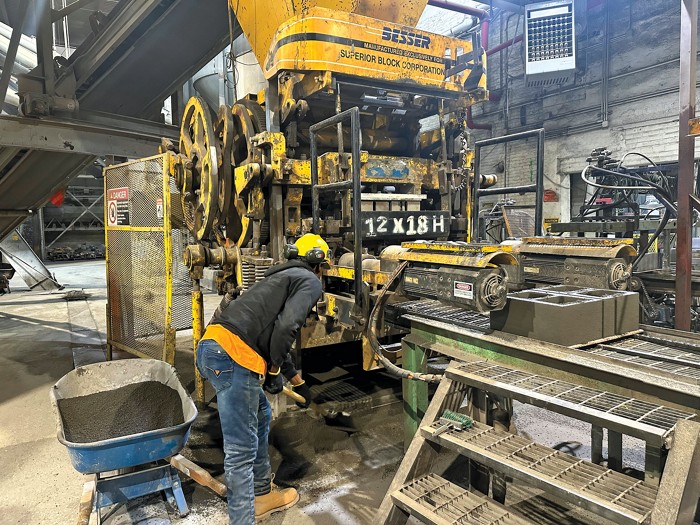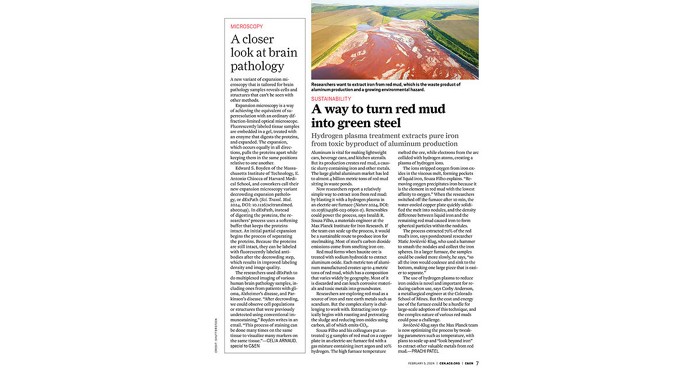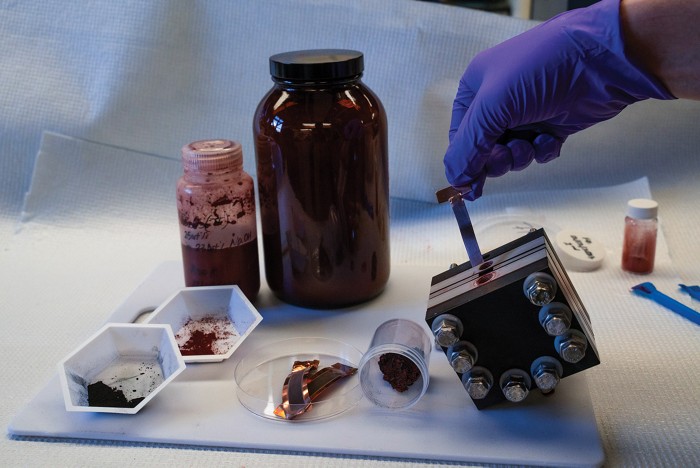Advertisement
Grab your lab coat. Let's get started
Welcome!
Welcome!
Create an account below to get 6 C&EN articles per month, receive newsletters and more - all free.
It seems this is your first time logging in online. Please enter the following information to continue.
As an ACS member you automatically get access to this site. All we need is few more details to create your reading experience.
Not you? Sign in with a different account.
Not you? Sign in with a different account.
ERROR 1
ERROR 1
ERROR 2
ERROR 2
ERROR 2
ERROR 2
ERROR 2
Password and Confirm password must match.
If you have an ACS member number, please enter it here so we can link this account to your membership. (optional)
ERROR 2
ACS values your privacy. By submitting your information, you are gaining access to C&EN and subscribing to our weekly newsletter. We use the information you provide to make your reading experience better, and we will never sell your data to third party members.
Sustainability
New York City is becoming an unlikely carbon capture hub
Carbon dioxide emitters and users are piloting technology in the Big Apple
by Craig Bettenhausen
March 15, 2024
| A version of this story appeared in
Volume 102, Issue 8

Down in the subbasement of a luxury apartment building in Manhattan, New York residents gave up five precious parking spaces to make room for a new idea: equipment that will strip carbon dioxide out of the flue gas from the building’s twin 350-horsepower boilers, which crank out about 3.4 MW of power each.
Instead of exhausting the hot, wet products of methane combustion from the roof, Paramount Tower will drop treated water into the sewer, vent a room-temperature mix of oxygen and nitrogen at street level, and send CO2 away as liquid in a refrigerated truck.
The building’s carbon capture equipment is from the start-up CarbonQuest, which is also building a network of customers who want CO2. The first buyer is Glenwood Mason Supply, a concrete-block maker across the East River in Brooklyn.
Carbon capture is one of several ways that buildings in New York City are complying with Local Law 97, an aggressive climate change regulation that puts caps on greenhouse gas emissions from new and existing structures larger than 25,000 ft2 (2,322 m2).
Though CO2 is a liability for large landlords in New York City—as well as almost everyone else—it’s also an opportunity for companies aiming to commercialize technologies that use CO2. Incentives, demand for low-carbon spaces, and a strong local talent pool are making the city into a hub for cleantech businesses, including those focused on carbon capture and utilization. The city is not likely a place where technologies for making chemicals and materials from CO2 will be deployed at scale, but it could be a fertile breeding ground for climate-tech start-ups.
Local Law 97
New York City has roughly 1 million buildings across its five boroughs, according to the city’s Department of Buildings. They emit a total of about 36 million metric tons (t) of CO2 per year—70% of the city’s total emissions.
Almost 28,000 buildings are covered by Local Law 97, according to sustainability consultant Jimmy “the Greenfather” Carchietta. His company, the Cotocon Group, offers third-party verification so building owners can prove their compliance with the law and other environmental legislation. The firm also advises clients on how to bring their buildings up to the new standards.

“The greatest return on investment for building owners is investing in energy efficiency,” Carchietta says. A lot of buildings were constructed when energy was cheap and emissions were free. Basic things like insulation, air sealing, and lighting upgrades make a huge difference and can bring some properties all the way into compliance, he says.
The city’s other main lever for accomplishing the decarbonization required by Local Law 97 is electrification, mostly through heat pumps, which can allow electricity to replace fossil fuels as a way to keep rooms warm and showers hot.
Why, then, did Glenwood Management go with carbon capture for Paramount Tower and four other properties? “For these five buildings, electrification would involve major retrofits that would impact our residents,” says Josh London, a senior vice president at the company, which is not related to Glenwood Mason. “In some properties, rewiring would even require that tenants relocate for a long period, potentially up to an entire year.”
Glenwood Management owns 26 buildings, London says, and has “many different prongs to our building decarbonization and energy efficiency campaign, such as motor upgrades, variable frequency drives, modulating valves, steam distribution improvements, and new building-management systems. We were, however, able to make the biggest, fastest impact on our emissions reductions by deploying the CarbonQuest systems.”
Paramount Tower is a 52-story apartment building in the Murray Hill neighborhood of Manhattan, a few blocks from the United Nations complex and the East River. Units rent for between $4,000 and $10,000 per month. The carbon capture system started operation at the beginning of December.
CarbonQuest had previously installed a smaller system at the Grand Tier, another Glenwood Management building, near the southwest corner of Central Park. CarbonQuest’s senior vice president for operations, Doug Staker, says the firm is installing a third system now; preparing a fourth for shipment from CarbonQuest’s factory in Spokane, Washington; and performing final assembly on a fifth. All are bound for Glenwood Management sites in New York City.
Staker declines to detail how much the installations cost, but he says they are competitive with other options that would enable building owners to comply with Local Law 97.
Both of the current installations are bolted onto fossil fuel boilers that supply radiator heat and hot water to residents. A damper valve above the boilers diverts some CO2-rich flue gas into a duct that runs through a cinder block wall and into a separate room housing CarbonQuest’s equipment.
As the flue gas enters the room, heat exchangers drop the temperature from 132 °C to 21 °C, a change that strips out most of the water. The next few machines filter, pressurize, and further dry the gas, which at that point is a mixture of CO2, nitrogen, and oxygen.
From there, the gas flows into the heart of the machine, a set of 12 columns, each about the size of a standard 49 L compressed gas cylinder. Each one is packed with a zeolite that preferentially adsorbs CO2 at high pressures. After the zeolite is saturated, the system releases the pressure to remove the nitrogen and oxygen; the CO2 stays behind, stuck to the zeolite. Operators then pull a vacuum to extract the CO2 at a purity of about 98%. Compressors and heat exchangers condense the CO2 to a –30 °C liquid.
In the depth of winter, when heating demand is highest, the system takes about 2.5 days to fill its 3,000 L storage tank, which holds roughly 3 t of CO2, Staker says.
The block factory
The two firms named Glenwood have been a part of CarbonQuest’s New York City plans from near the beginning. Glenwood Mason even owns the truck that picks up CarbonQuest’s CO2 from Glenwood Management’s buildings.

Jeff Hansen, Glenwood Mason’s vice president for architectural sales and marketing, says that incorporating CO2 shaves about 5% off the greenhouse gas footprint of each block. It makes the blocks slightly stronger as well but not enough to change how they’re used. “We’re doing it totally for our environment,” Hansen says.
Glenwood Mason has been making CO2-infused blocks for about 6 years. At this point, all 60 of its block types include CO2, which becomes a mineral inside the concrete. It has paid off, Hansen says, because more and more governments and private companies are specifying lower-carbon concrete when planning construction projects.
CO2 mineralization isn’t part of the main set of chemical reactions—the hydration of various calcium silicates—involved in setting concrete. But after concrete sets, it slowly absorbs ambient CO2, which reacts with calcium hydroxide to form calcium carbonate. The process is one reason why concrete continues to get stronger for months or years after its initial setting. “We speed that up,” Hansen says. Natural carbonation “takes years to do what we do in 3 min.”
Inside two giant cylinders above the control room in Glenwood Mason’s plant, augers about 1.5 m in diameter slowly churn the dry ingredients that will become concrete blocks a few minutes later. A small insulated pipe leading from a tank outside carries liquid CO2 to a nozzle at the top of the mixer.
The catwalk between Glenwood Mason’s mixers gets noticeably colder when injection starts, and the room begins to smell faintly of machine oil. The process mineralizes about 70% of the injected CO2, Hansen says. Glenwood Mason’s R&D team is working on ways to improve that number. Reducing CO2 loss would give the firm’s products a better carbon footprint and save money on gas supply.
The impact could go beyond just absorbing CO2 faster. Blocks like Glenwood Mason’s are often sealed away from the open air shortly after they’re made, placed in foundations underneath paint, tile, plaster, and other finish materials. Mixing the CO2 into the bulk material gives access to reaction sites that would otherwise be inaccessible to CO2, so more total greenhouse gas can be locked away.
Glenwood Mason is also exploring ways to use more CO2. In November, only the Grand Tier was yielding regular loads of the gas, and that was enough to supply all of Glenwood Mason’s needs. CarbonQuest should have a surplus soon, with three units operating and at least two more in the pipeline. “Thus far, everything has gone to Glenwood Mason, and it’s all either been used by them or stored on-site,” Staker says. “CarbonQuest is currently negotiating with additional CO2 offtakers.”
One idea is to cure the blocks in a CO2-rich atmosphere. Glenwood Mason normally cures its blocks in ambient air heated to about 57 °C and spiked to 100% relative humidity.
The factory’s lab, an air-sealed room with a thick layer of spray insulation on the ceiling to control temperature and noise, contains a cast-iron kiln that is a little smaller than a household oven and is fitted with valves, pipes, and gauges. Glenwood Mason’s R&D team can add CO2 at various concentrations to concrete samples curing inside and then analyze the resulting blocks and oven air to see how much soaked in and how it affected the product.
Even if CO2-enhanced curing works, Glenwood Mason can take only so much CO2 for its blocks. But it’s far from the only concrete supplier in the area. Brooklyn has a slew of factories that prepare ready-mix concrete, the kind that’s poured on-site from a rotating drum on a truck.
CO2 to chemicals
And mineralization in concrete isn’t the only use for CO2. Air Company is among the most commercially advanced firms using the greenhouse gas as a feedstock for making chemicals. The company’s technological heart is its suite of CO2 hydrogenation catalysts, though it also has patents on parts of the downstream technology for the separation of water, methanol, ethanol, and jet fuel, its main target product.

Air Company’s pilot plant is a hangar-style building in a Brooklyn neighborhood quickly shifting from heavy industry to retail, entertainment, and fine goods. The hangar next door is a nightclub, and the warehouse across the street is a fancy event venue. The plant’s other neighbor is an empty lot where developers are building a vegan food hall. “We’re a bit of a rose among thorns here,” says Stafford Sheehan, the firm’s cofounder and chief technical officer.
CarbonQuest would love to land Air Company, one of C&EN’s 10 Start-Ups to Watch in 2022, as a customer. Sheehan estimates that the pilot plant’s demand for CO2 is roughly a match for the amount generated by one high-rise fitted with carbon capture equipment.
The two companies are in conversation, but Sheehan says the natural gas origin of CarbonQuest’s CO2 is a problem. Air Company wants to minimize the full-life-cycle greenhouse gas emissions of its products, and converting captured fossil fuel CO2 into chemicals or fuel would still mean a net increase in the greenhouse gas in the atmosphere.
Instead, Air Company buys its CO2 from ethanol companies. Fermentation generates CO2, but it is CO2 that originally came out of the air by way of photosynthesis, so Air Company considers the overall process to be circular.
Boiler-captured CO2 might not be green enough for Air Company’s pilot plant in Brooklyn, but the numbers could line up differently at other CO2-to-chemical projects.
Advertisement
Air Company has picked a site for its next scale-up, and it’s not in the city, Sheehan says. “Nobody wants a full-scale jet fuel facility in the middle of NYC,” he says. And power is an issue. Chemically reducing CO2 in a carbon-neutral way requires green electricity, a resource that is limited on the New York City grid.
Still, Sheehan is cautiously optimistic about the carbon scene developing in New York City. “There’s a good chance for some kind of local CO2 economy, but it will take time to mature,” he says. Users in the city alone will be hard pressed to consume all the CO2 its buildings might capture. But for start-ups, an ample gas supply, a strong talent pool, and support from the city and nonprofit entities are nurturing a growing climate-tech community.
Diamonds from CO2
In the midtown Manhattan offices of the lab-grown-diamond start-up Aether Diamonds, CEO Ryan Shearman keeps a 5 carat (1 g) gem that he likes to show to visitors. The firm is conceptually similar to Air Company. Aether’s methanation process chemically reduces CO2 with hydrogen to make methane. Aether then feeds the methane into a chemical vapor deposition (CVD) apparatus that atomizes it into elemental carbon and deposits it atom by atom onto a seed crystal to produce jewelry-sized diamonds.
Like Air Company, Aether was founded in New York City. The methanation apparatus was developed in a lab in Queens, and Aether’s in-house jewelry brand is handmade by a jeweler in Manhattan’s Diamond District.
And Aether is also scaling up somewhere else. The Queens lab was dismantled and turned into a unit the size of a shipping container, which is currently outside Paris. Aether will soon move all its equipment to Surat, India, which Shearman describes as the global hub for growing diamonds as well as cutting and polishing them. The move, he says, will give Aether access to the newest, most efficient CVD reactors.
Also in common with Air Company, the source of Aether’s CO2 matters a lot for the story it’s trying to tell. A good amount of the CO2 it has made into gemstones so far has come from Climeworks Iceland facility, which pulls carbon dioxide directly out of the atmosphere, a process known as direct air capture (DAC). It was OK to spend more than $10,000 per metric ton on early shipments of CO2 because the resulting stones were worth more than $2 million, Shearman says. “We’re somewhat price insensitive on the CO2.”
Long term, Aether plans to acquire its own DAC rigs, including at least one mobile unit it could use to catch CO2 at marquee events. “Imagine LeBron James sinking a game-winning shot in the championship, and there’s a carbon capture unit at half-court. That moment has now been captured in solid diamond form forever, and it goes into the championship rings,” Shearman says.
He is realistic about the climate impact of lab-made gemstones. “Will diamonds aggregate to gigaton scale? Absolutely not. But I’ll have more people talking at the dinner table about our diamonds than will talk about gigaton-scale solutions,” he says.
Diamonds also aren’t the only target market for Aether. Its core intellectual property is about turning CO2 into methane, which is a fuel and chemical feedstock. “Diamonds are measured in carats; carbon black is measured in tons,” Shearman says. “So that’s where things start to get interesting. We want to use diamonds as a foundation upon which we can build a business.”
Circularity
The pieces of a New York City circular carbon economy are almost coming together. CarbonQuest captures CO2 from boilers that burn hydrocarbon fuels; Air Company and Aether can make hydrocarbon fuels out of CO2. True circularity is technically possible, if not economically feasible.

Neither Air Company nor Aether has any current plans to make heating fuel for the city. The profit margins on sustainable aviation fuel and diamonds make those products pay out better than any heating fuel would.
Still, Shearman says New York City is a good place to build a carbon-tech company because it attracts talented people with an interest in sustainability. “This is a finance city; this is a media city. There’s so many things that happen here,” he says. “But you have this highly concentrated pocket of people who are smart, driven, hardworking, all working towards this common shared goal.”
Shearman says he’s impressed by the climate-technology entrepreneur community in the city. “Local Law 97 played a big role there,” he says. “All of a sudden, there was a climate community popping up in New York, which was really cool to see. So many different companies are taking so many different approaches to circularity and carbon management.”
With additional reporting by Priyanka Runwal




Join the conversation
Contact the reporter
Submit a Letter to the Editor for publication
Engage with us on Twitter